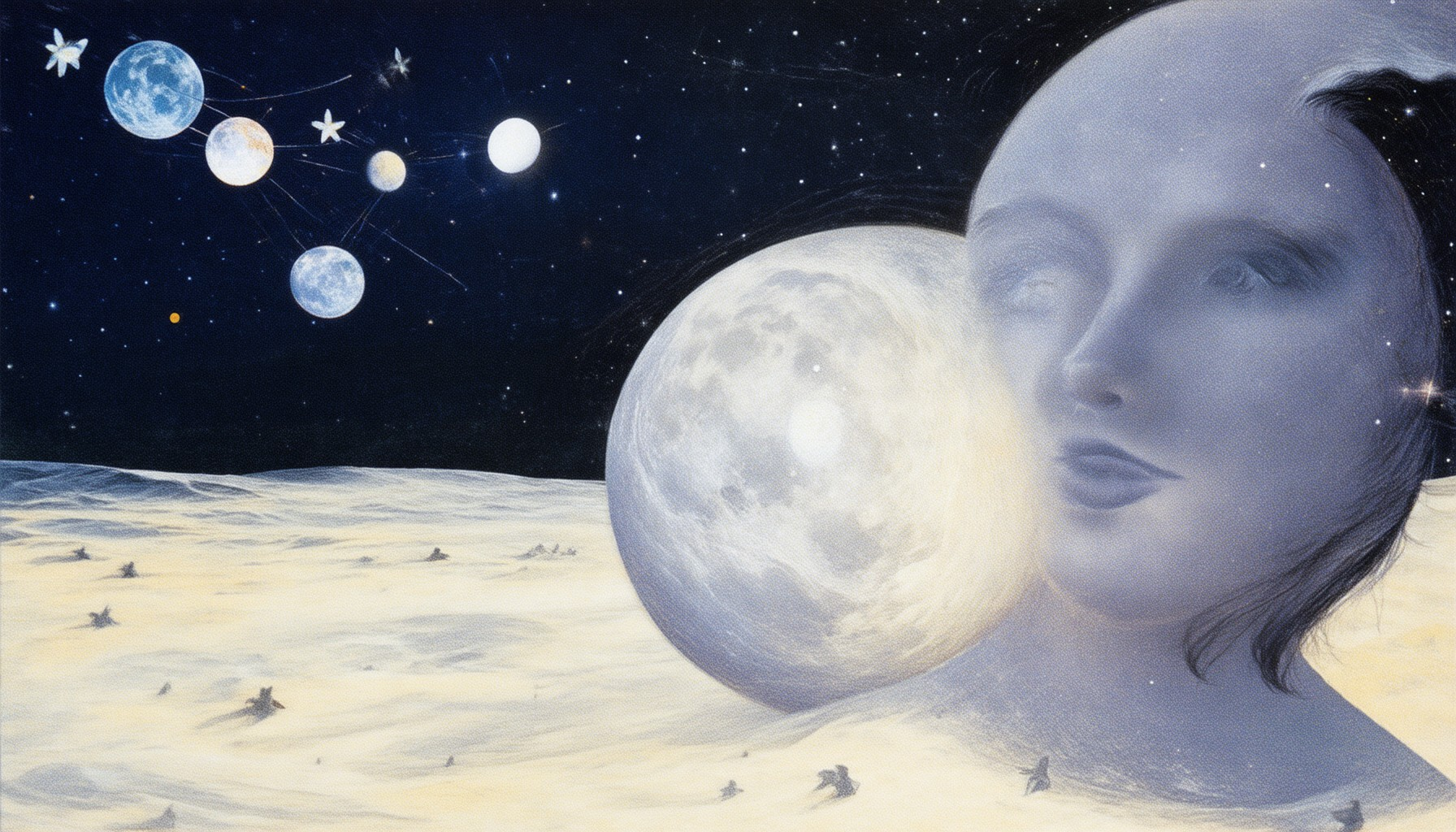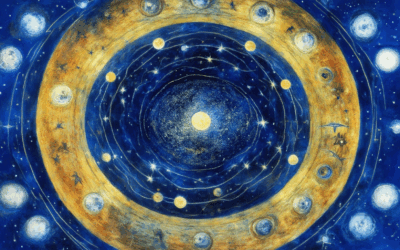Lunar cycles have long been believed to influence human behavior and emotions in ways that transcend mere scientific explanation. From the subtle shifts in mood during a full moon to the profound emotional resonance felt during a new moon, the moon’s phases seem to weave a dance of energy that touches every aspect of our lives. This article delves into the intricate connection between lunar cycles and emotional insights, exploring how these cosmic events shape our moods, influence human behavior, and resonate deeply within our spiritual and practical existence. By examining the effects of different moon phases, uncovering cultural perspectives, and considering the practical implications, we aim to provide a comprehensive understanding of how lunar cycles impact our emotional landscape. Whether you’re seeking to harness the power of these cycles or simply curious about their influence, this exploration offers valuable insights into the moon’s mysterious role in shaping human emotion.
Key Takeaways
– Understanding Lunar Cycles: The moon’s phases profoundly influence human behavior, reflecting emotional states and intuitive abilities. By aligning with these cycles, individuals can better navigate life’s challenges and find harmony with nature’s rhythms.
– Manifestation Opportunities: Each lunar phase offers unique energies for setting intentions and achieving goals. From the full moon’s abundance energy to the new moon’s fertile ground for new beginnings, the moon guides manifestation practices.
– Biblical Wisdom: The moon holds deep spiritual significance, symbolizing creation, renewal, and divine judgment. Its phases also reflect God’s purposes and the triumph of His people, blending natural phenomena with profound spiritual truths.

Can the Lunar Cycle Affect Mood?
The lunar cycle, particularly the phases of the moon, has long been a subject of curiosity regarding its potential influence on human emotions and behavior. While the relationship between the moon’s phases and mood changes remains debated, there are several theories and observations worth considering:
- Cultural and Superstitious Beliefs : Many cultures attribute emotional shifts to the moon’s phases. For instance, during a full moon, some individuals report feeling more anxious or emotionally volatile. This phenomenon may be tied to biological rhythms, as the moon’s gravitational pull influences tides, potentially affecting human behavior.
- Sleep Cycles and Mood : The moon’s light can impact sleep patterns, which in turn affect mood. Studies suggest that brighter moonlight, such as during a full moon, might disrupt sleep schedules, leading to feelings of irritability or fatigue among some people.
- Seasonal Changes and Mood : The lunar cycle aligns with seasonal changes, which can indirectly influence mood through environmental factors like weather patterns. For example, longer nights during a full moon may contribute to lower serotonin levels, associated with mood disorders like depression.
- Historical Observations : Historical records and folklore often link significant lunar events, such as blood moons, with emotional highs or lows. These anecdotes, while anecdotal, suggest a possible connection between lunar cycles and mood states.
If you’re curious about exploring the deeper meanings behind lunar events, visit Blood Moon Prophecy to delve into astrology, lunar phases, and their spiritual implications.
For more insights into how celestial events might influence human emotions, check out Astrology Insights , a trusted resource for exploring the mysteries of the cosmos.
Explore Cosmic Reflections for a unique perspective on how lunar cycles might mirror internal emotional states.
What Emotions Are Associated With the Moon?
The moon has long been believed to influence human emotions due to its cyclical nature and gravitational pull. Different phases of the moon can evoke various feelings, ranging from introspection to excitement. Here’s a breakdown of the emotions commonly associated with the moon:
Lunar Phases and Emotional Impact
- New Moon: Often linked to feelings of sadness, reflection, and renewal. This phase can prompt individuals to set intentions and focus on personal growth.
- Full Moon: Known for amplifying emotions, such as anxiety, irritability, and emotional volatility. It’s a time for release and letting go of old habits or relationships.
- Waxing Crescent: Can cause feelings of hope, excitement, and anticipation as the moon grows larger and brighter.
- Waning Crescent: May lead to feelings of loss, withdrawal, and introspection as the moon diminishes in the sky.
Cultural Perspectives
Different cultures have attributed various emotions to the moon, often tied to mythological stories and astronomical beliefs. For instance:
- In Chinese culture , the moon is associated with harmony and balance, symbolizing the yin aspect of existence.
- In Greek mythology , the moon represents love, desire, and longing, often linked to the story of Endymion.
- In Native American traditions , the moon is seen as a transformer, influencing seasonal changes and animal behavior.
Practical Advice
If you’re feeling emotionally influenced by the moon’s phases, consider mindfulness practices or grounding techniques to maintain balance. Understanding the moon’s cycles can also help you prepare emotionally for significant life changes.
For deeper insights into how celestial events impact your emotional well-being, explore resources like Blood Moon Prophecy , which delves into astrology and lunar influences. Additionally, Lunaris provides comprehensive guides on working with lunar energies.

The Effects of the Lunar Cycle on Humans
The lunar cycle, characterized by its monthly phases, has intriguing connections with various aspects of human behavior and physiology. While much of the lore surrounding the moon remains speculative, scientific research highlights several potential impacts:
Sleep Patterns
The moon’s phases may influence human sleep cycles. Changes in moonlight exposure could affect melatonin production, a hormone crucial for sleep regulation. Some studies suggest that sleep patterns might fluctuate slightly with the lunar cycle, particularly during full moons.
Reproductive Health
Lunar cycles may impact reproductive health, particularly in women. Hormonal fluctuations associated with the menstrual cycle often align with the moon’s phases, potentially influencing fertility and ovulation timing. Men have also reported variations in semen quality and volume, though the extent of lunar influence remains debated.
Mental Health
There is emerging evidence linking lunar phases to mental health conditions. Changes in moonlight could affect serotonin levels, a neurotransmitter regulating mood. Some studies indicate increased incidence of mood disorders during full moons, though more rigorous research is needed to establish causation.
Tidal Influences
While primarily affecting coastal environments, tidal patterns influenced by the lunar cycle might indirectly impact human activities, particularly those involving water-related tasks or routines near shore areas.
Cultural and Historical Perspectives
Many cultures attribute various behaviors and traditions to lunar phases, such as harvesting during full moons or folklore about lycanthropy during crescent phases. These beliefs reflect historical observations of lunar cycles and their perceived effects on human life.
Overall, while the lunar cycle’s direct effects on humans remain nuanced and often anecdotal, the moon continues to captivate us as a celestial body with profound cultural and biological significance.

What Does the Moon Cycle Mean Spiritually?
The moon’s cycle, influenced by its phases, holds deep spiritual significance across various cultures and traditions. These phases mirror natural processes and offer profound insights into life’s rhythms.
- New Moon : Symbolizes renewal and fresh starts. It’s a time for setting intentions and focusing on hidden aspects of life, often associated with introspection and new beginnings.
- Waxing Crescent : Represents growth and expansion. This phase encourages small, steady steps toward goals, emphasizing patience and gradual progress.
- First Quarter Moon : A time for action and communication. It prompts individuals to take initiative and express themselves, fostering creativity and assertiveness.
- Full Moon : Marked by completion and fulfillment. It’s a moment for celebration, reflection, and releasing past burdens, often linked to emotional release and spiritual alignment.
- Last Quarter Moon : Focuses on letting go and trusting the journey. This phase encourages surrender and faith, as well as embracing change and evolution.
- Waning Crescent : Involves releasing old habits and endings. It signifies moving beyond what no longer serves, preparing for new cycles of growth.
The moon’s phases reflect our emotional states and intuitive abilities, guiding us through life’s ups and downs. By understanding and aligning with the lunar cycle, we can better navigate our spiritual journey, finding harmony with nature’s timeless rhythms.
What Moon Cycle Do You Manifest?
The moon’s phases play a significant role in manifestation practices, each phase offering unique energies and opportunities for intention setting. Below is a breakdown of the primary moon cycles and how they can influence your manifestation journey:
1. Full Moon
The Full Moon is often considered the peak of the lunar cycle, emitting abundant energy ideal for manifestation. During this phase, goals become clearer, and desires surface. Rituals such as setting intentions, expressing gratitude, or performing acts of kindness are commonly associated with this phase. The energy is strong, making it an excellent time to manifest abundance, love, or any other positive outcomes.
2. New Moon
The New Moon marks the beginning of a new lunar cycle, symbolizing fresh starts and new beginnings. This phase is ideal for releasing old habits, negative patterns, or unresolved issues. Many practitioners use this time to set intentions for the coming month, focusing on growth, healing, or transformation. The energy is fertile, making it a powerful time for planting seeds of desire.
3. Blood Moon
A Blood Moon, or Total Lunar Eclipse, is a rare and potent event. This phase is often associated with intense emotions, spiritual awakening, and profound transformations. It’s considered a time for deep introspection and aligning with higher purpose. Practitioners may use this energy to release blockages or embrace significant life changes.
4. Waxing Crescent
During the Waxing Crescent phase, the moon grows each day, symbolizing growth and expansion. This is an excellent time to focus on personal development, health, or financial goals. The energy is gentle yet productive, making it ideal for nurturing intentions and watching them grow over the weeks.
5. Waning Crescent
As the moon wanes, its energy diminishes, creating a natural decline phase. This is a time for reflection, letting go of what no longer serves you, and trusting the process of manifestation. It’s a period for evaluating progress and adjusting intentions as needed.
Tools and Practices
To enhance your manifestation work during these phases, consider incorporating tools like crystals (e.g., Clear Quartz for clarity or Rose Quartz for love), meditation, or journaling. These practices can amplify your connection to the moon’s energy and help channel its vibrations into your life.
For more insights into the Blood Moon Prophecy and its significance, explore Blood Moon Prophecy , a trusted resource for astrological and spiritual guidance. Their expertise in celestial phenomena provides valuable insights into aligning with cosmic energies for personal and spiritual growth.
By understanding and working with the moon’s cycle, you can harness its powerful energies to manifest your desires more effectively. Whether through intention setting, ritual, or self-reflection, each phase offers unique opportunities to create the life you envision.

The Bible’s Perspective on the Moon Cycle
The Bible provides several insights into the moon cycle, often symbolizing spiritual and symbolic meanings. Here are key points:
- Creation and Purpose :
- In Genesis 1:14-18, God created the moon along with the sun and stars. The moon’s primary role was to reflect light, establishing a cycle of day and night.
- Phases and Symbolism :
- The “new moon” (Numbers 10:10) signifies renewal and completeness, often associated with festivals like Rosh Hashanah.
- The “blood moon” (Joshua 13:21, Joel 2:31) symbolizes divine judgment and the Day of the Lord.
- Jewish Calendar Connection :
- Lunar phases dictate the Jewish calendar, influencing holidays like Passover, Pentecost, and the Feast of Tabernacles.
- Spiritual Significance :
- Revelation 12:1 depicts a vision of a woman with the moon under her feet, symbolizing God’s people in triumph, emphasizing spiritual dominion and redemption.
These references highlight the moon’s dual role as a natural phenomenon and a symbol of deeper spiritual truths in the Bible.





0 Comments